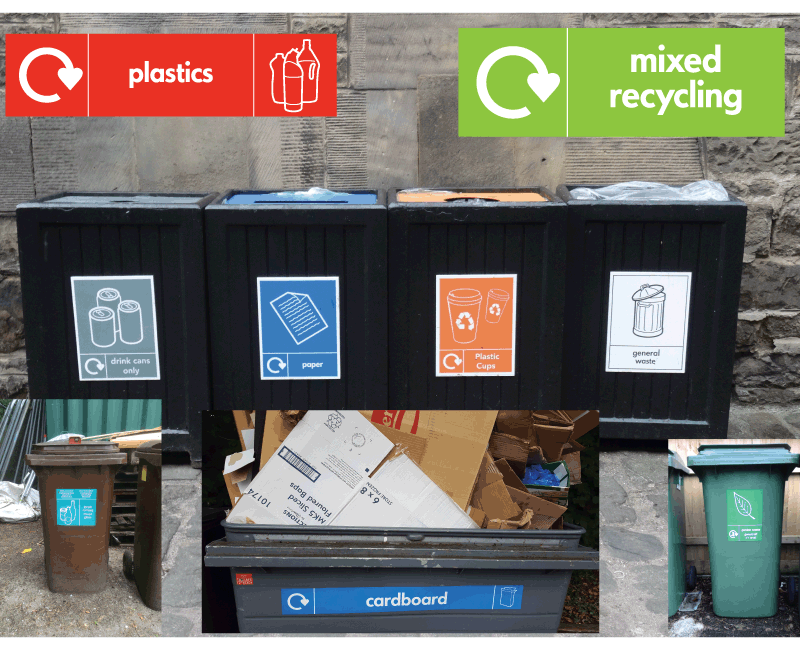 Recycling is a crucial part of conserving resources and is one of the most significant things someone can do to help the environment. Furthermore, recycling minimises pollution from rubbish disposal, saves energy, and creates jobs.
Recycling is a crucial part of conserving resources and is one of the most significant things someone can do to help the environment. Furthermore, recycling minimises pollution from rubbish disposal, saves energy, and creates jobs.
There are more and more alternatives for recycled content materials on the market for eco-friendly labels. We will explain what recycling content is, the history and progression of recycling in the UK, as well as how you can improve your recycling situation with Label Source’s recycling signs and labels.
What is Recycled Content?
The overall amount of recovered material in a product, including pre and post-consumer resources, is referred to as "recycled content."
Recycled content is "the percentage, by mass, of recycled material in a product or packaging," according to ISO 14021. According to the definitions, only pre and post-consumer products shall be regarded as recycled content.
UK Recycling Progression
In 2000, Friends of the Earth began advocating for a new recycling law, which would have given every home in the UK access to a doorstep recycling service. This would make recycling as simple as putting out the rubbish.
The bill would require local governments to offer a separate collection of at least two different types of recyclable materials to every household in England by the year 2010.
30th October 2003, the Household Waste Recycling Act cleared the House of Lords and received Royal Assent at the end of its rollercoaster journey through parliament. The law meant that everyone could easily take part in recycling from home.
By 2016, the UK's household waste recycling rate had increased to 43% as a result of the 2003 Household Waste Recycling Act. The Act also gave Wales the option of passing similar legislation, which they most definitely did. Wales is currently one of the top 3 recyclers in the world.
Recyclable Labels
The Department for Environment, Food, and Rural Affairs (Defra) reports that in 2017, households in the UK recycled 45 percent of total domestic waste. While everyone is recycling more, our labels weren’t necessarily being recycled properly.
Introduction of Binary Labelling System
In 2020, OPRL, the market-leading recycling label not-for-profit launched a new ‘binary labelling system’.
The OPRL label has three categories that now indicate the likelihood that a local authority will accept a certain type of packaging for recycling:
- Commonly recycled (75 percent or more of UK local authorities collect that type of packaging).
- Local recycling (between 20 percent and 75 percent of UK local authorities collect that type of packaging).
- Not recycled at the moment (fewer than 20 percent of UK local authorities collect that type of packaging).
The majority of packaging are now labelled "Recycle" or "Don't Recycle" under the new system, depending on whether it is gathered, sorted, and processed and whether there is a market for the recycled materials.
To prevent contamination issues, any waste that is not collected by at least half of the UK councils is labelled "Don't Recycle."
Environment Act 2021
In the UK, mandatory recycling labelling on all packaging is now one step closer thanks to the passage of the Environment Act 2021. The Act introduces a new governance framework that should facilitate the advancement of numerous other crucial environmental initiatives.
The much-debated Environment Bill, which enables the Government to mandate recycling labelling for containers, became law as the Environment Act. This brings mandatory labels one step closer.
Why is Recycling Labelling Important?
Sorting waste is essential for recycling. Glass, plastic, aluminium, and paper containers should all be disposed of in the corresponding waste bins. It is straightforward and easy. It might not be sufficient, though. What about the containers' labels and adhesive? If they are not recyclable, a new issue will arise. If the glue is not recyclable, it can substantially obstruct recycling efforts, preventing the recycling of the paper, and ultimately leading to greater waste in landfills.
Fortunately, recyclable stickers are an option today, and responsible label makers employ it in their processes for producing labels. These labels are recyclable since there is a water-soluble barrier between the paper and the adhesive. The paper recycling sector would greatly benefit if these types of labels were used globally.
Label Recycling Today
In the UK, the majority of food packaging includes details on how to properly dispose of the product. Furthermore, recycling packaging is already, for the most part, ingrained behaviour.
Implementing what is now largely a social norm has been aided by improvements to recycling infrastructure and communications as well as a new social narrative. There is certainly room for improvement, and simply having recycling labels and information available is not always enough to promote ethical recycling practises.
The information on the label or on the packaging about recycling must be read carefully by the consumer, understood, and applied when the item is disposed of.
How to Make Label Recycling Easier
Match the right label material to the packaging of your goods. Place paper labels on cardboard or paper packaging and PE or PP labels on those materials' packaging.
- If your labels and packaging are properly matched, instruct customers to keep the labels on, clean any bottles or containers, and place them in the recycling bin.
- On your packaging, clearly print the recycling logo.
- Do not apply compostable labels to recyclable plastic or glass packaging.
- Customers should be asked to refrain from recycling labels that can be composted.
Become Eco-friendlier with Label Source
Here at Label Source we offer a wide range of recycling signs that can be used to promote recycling and encourage environmentally-friendly waste management in a wide variety of settings.